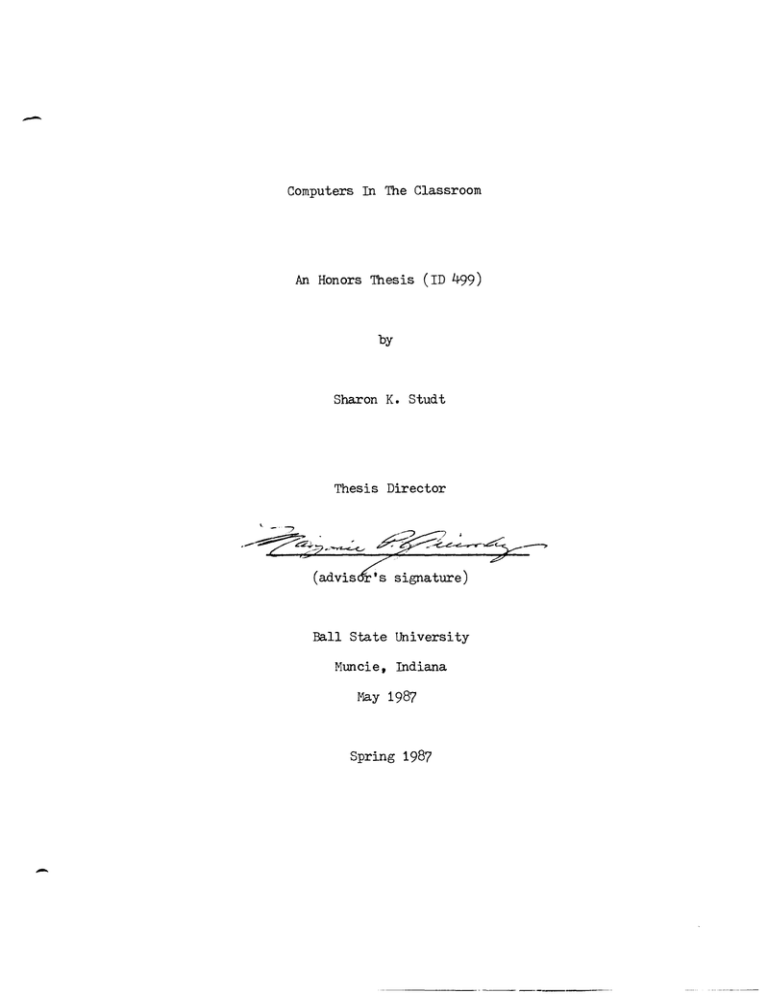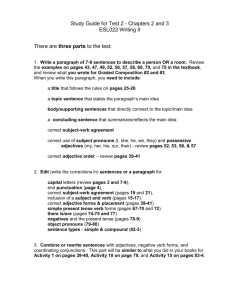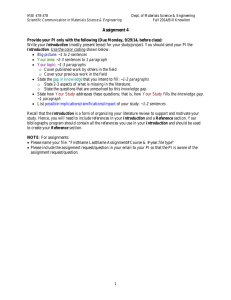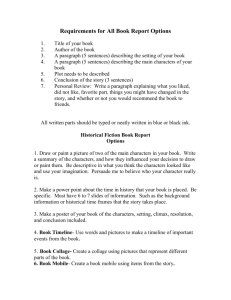- An 499)
advertisement

computers In The Classroom An Honors Thesis (ID 499) by Sharon K. Studt Thesis Director Ball State University Muncie, Indiana May 1987 Spring 1987 ------------------- _ .~'I.."'l,)l TABLE OF CONTENTS INTRODUCTION LESSON PLAN S : 1. ABC Order 2. Con tractions 3· ~1ain 4. Prefixes 5· Pronouns 6. Punctuation WORKS CITED COHPUTER DISK - Idea computers In The Classroom In this increasingly computer literate age, it is likely as well as expected that everyone be computer literate. Computer literacy usually begins in the elementary classroom with basic practice and keyboard familiarization. As a future educator at the elenentary level, I feel it is necessary for me to become computer literate in order to aid students in their acquisition of computer skills. In addition to my computer skills, it is necessary to let the children experience working with a computer in order to enhance their understanding of and skills with the computer. Since most school corporations tend to use the Apple System, I have decided to concentrate on this system so that I will be able to use my programs in my future classrooms. In considering my senior honors project, I feel it is pErrtinent to work on an area that will improve my teaching skills. Since the computer is rapidly becoming an integral part of society, it must become an integral part of the classroom. I feel that by concentrating on computer skills in the elementary classroom I, as a teacher, will be able to offer more experiences to my students. In order to begin my senior honors thesis, I reviewed sl9veral elementary level language textbooks to find the basic language skills taught at the third grade level. on six main skills. Of these basic skills,I chose to focus For each skill I developed a lesson plru~ to be used wi th an entire third grade class and an extended practice computer program for the children to complete on an individual basis. In conclusion, computers in the elementary classroom introduce the - students to basic, necessary computer skills as "Tell as assisting in the teaching of language skills. classroom in the future. I plan to use these computer programs in my - ABC ORDER I. OBJECTIVE: Students will be able to alphabetize words by using the first letter, second letter and third letter when needed. II. PROCEDURE: 1. 2. J. I will say the letter "A" and give the word "apple." I will then ask the students to complete the alphabet in this manner taking turns. I will explain alphabetical order as the order of letters from "A" to "Z", used to find words in reference sources. I will wri te the following examples on th!~ board: a) First letter order !'pple b) banana I'll explain that we look at the first letter of each word and put them in the order they appear in the alphabet. Second letter order-used when all first letters are the same circus c) 5. 6. - III. NA TERIALS: IV. EVALUATION: clown costume Same as above only order them by second letter. Third letter order-used when first and second letters are the same coach 4. .2,Tange co£.gressman cook counselor Same as above using third letter. I will leave these rules on the chalkboaro and continue to practice using the following examples. I will write these words on the board and have stud en ts come to the board and write them in alphabetical order. a) cake, pie, strudel, ice cream bl blue, red, yellow, green c chips, candy, cookies, crackers d church, choir, chimes, chairs Students will stand and, with my help, arrange themselves in alphabetical order using their first names. Next, students will write lists in alphabetical order using these directions: a) Think of and list your three favorite colors. b) Think of and list the three months beginning wi th "J". c) Think of and lis t the first name,s of the members of your immediate family. chalkboard, chalk, pencil, paper. I will check the student's lists to make 9ure they are alphabetized. v. EXTENDED PRACTICE: Students will practice this ski2.l by using computer program ABC ORDER. -- CONTRACTIONS I. OBJECTIVE: Students will be able to combine a helping verb with "not" in order to create a contraction. II. PROCEDURE: 1. 2. 3. 4. 5. I will write two sentences on the chalkboard and have a student read them aloud and repeat the helping verb. a) The fireman is cleaning his boots. b) The fireman is not cleaning his boots. I will then write twomore-sentences on the board and have them read aloud. c) The fireman ~£2i on duty. d) He does not drive the firetruck. What are the helping verbs? Next, I will write the same two sentences on the board and have them read aloud with the student noticing the change in words. e) The fireman isn't on duty. f) He doesn't drive the firetruck. I will then explain that these shortened forms of " is not" and "does not" are contractions. An apostrophe is used to take the place of the letter or letters removed from the word. I will list these common contractions on a poster chart to be posted at the front of the classroom. These will be read aloud and discussed: is + not = isn't have + not = haven't are + not = aren't has + not = hasn't does + not = doesn't 6. was + not = wasn't were + not = weren't had + not = hadn't did + not = didn't can + not = can't The students will take turns completing a. manipulative bulletin board pairing contractions with the words that are combined to create the contraction i.e. can't= can + not. Words to be used are as follows: aren't, isn't, hasn't, wasn't, hadn't, weren't, can't, haven't. III. MATERIALS: chalkboard, chalk, posterboard, manipulative bulletin board. IV. EVALUATION: There will be a checklist by the bulletin board in order for students to check their name off after completing the task. I will watch their progress thr'oughout the day. V. EX~fDED PRACTICE: Students will practice this skill by using the computer program CORRECT CONTRACTIOm;. -------------------------------- - 1. OBJECTIVE: Students will be able to listen to or read a paragraph and recognize the main idea of the paragraph. II. PROCEDURE: 1. 2. I will explain how to determine what the main idea of a paragraph is. Then I will read a paragraph and have the students listen for the main idea. I will then ask for a student to tell me the main idea. I will repeat the procedure using a different paragraph. Paragraphs to use: a) Some trains travel under the ground. They are called subway trains. They travel through large tunnels that have been dug in the earth and rock. Often people riding and walking above ground cannot hear the trains. (Some trains travel under the ground.) (language for Daily ~, p. 128.) b) ifuen Will opened his eyes, it was almost dark. He had fallen asleep in his "boat and had slept a11 afternoon! As Will put his fishing rod away, he discovered his second mistake. His boat had drifted far down the lake! He had forgotten to anchor it. Hhat a fishing trip this had been! (Will discovers his mistakes.) (Reading f2£ Different Purposes, p. 39.) 3. Next the students will receive a handout with the following paragraphs. They will read the paragraphs and circle or write the main idea of each paragraph. a) Donna takes good care Df her cat. First she feeds the cat. Next she :plays with the cat. Then she brushes the cat. (Donna takes good care of her cat.) (Macmillan English, p.20.) b) There is nothing quite like a summer thunderstorm. The day can be sunny and calm, and suddenly, it begins to happen. You can feel the wind begin to blow. The sky becomes bright wi th quick flashes of lightning. A:fter each flash, a crash of thunder is heard. Then the rain begins to pour down out of the sky. (Summer Thunderstorms.) (Reading for Different Purposes, p. 38.) - c) Some airplanes are huge. ThHY can carry hundreds of people. They may have five or more doorways. One big plane carried our first space shuttle on a test flight. (Some airplanes are huge.) (language for Daily~, p. 128.) d) The people are on this plane for many different reasons. Some people on the plane are on their way to business meetings. Others are going on vacation. Still others are moving to new homes. (The people are on this plane for many different reasons.) (Language for Daily ~, p.129.) e) It's a rainy Saturday, and I can't go outside. There must be something to do on a rainy day! I suppose that I could build a new cage for my rabbit. He really needs one. If I could find some red paint, I could paint my new model boat. Ny little brother wants me to make him a drum. I ~ess I'll be busy. (Things to do on a rainy day.) (Reading for DiffElrent Purposes, p. 40) f) Steve is always glad to see the winter come because he loves to play in the Snell and on the ice. ~lhen the water on the pond freezes over and the ice is safe, he goes iceskating as often as he can. After the first snowfall, he likes to coast down the big hill behind his house on his sled. Steve also likes to use the snow to build snowmen. (Steve likes winter.) (Reading for Different Purposes, p. 36.) III. MATERIALS: IV. EVALUATION: V. - ditto, paper, pencil I will collect the handouts and check to see if the students could find the main idea. EXTENDED PRACTICE: Students will practice this skill by using computer program NAGNIFICENT ~'lAnr IDEAS. -- PREFIXES I. OBJECTIVE: II. PROCEDURE: Students will be able to create new words by using prefixes and understand the meanings of the new words. 2. J. 4. I will hold up a sentence strip and ask a student to read the sentence aloud. a) John is happy that the circus is here. Next I will add a ~fix card to the sentence strip. a) John is LE£/happy that the circus is here. A student will read the new sentence aloud and try to explain the difference in meaning between the first and second sentences. I will construct a chart with help from the students. It will list the following three prefixes and their meanings. This will be posted for the students to refer to. re-------again un-------not or opposite of 5· I will ask the students to use the prefixes with the 6. 7· 8. III. f1ATERIALS: IV. EVALUATION: v. - underlined word in the following sentences on sentence strips. a) Tomorrow the phone worker will (re)connect my telephone. bcj It is (un)likely to rain tomorrow. "(Re)do your homework!" the teacher ordered. d If I don't win the lottery, I will be very (un)lucky. One student will come to the front of the classroom and using a prefix wheel will make a new word by adding a prefix to a root word. There will be two wheels containing the following words: reopen , relive, reconstruct, repay, redecorate, repaint, review, redo, rerun, unlike, unwritten, unsafe, uncaring, unselfish, unlucky, unhappy. The student will pronounce the word, define the word and use the word in a sentence. This game will continue until all students have had a turn. sentences strips, cards for prefixes, posterboard, marker, wheel games. I will listen and advise as the students pronounce the word, define the word and use the word in a sentence. EXTENDED PRACTICE: Students will practice this skill by using the computer program PREFIX PRACTICE. PRONOUNS I. OBJECTIVE: Students will be able to substitute pronouns in the place of proper nouns. II. PROCEDURE: 1. I will write the following story on butcher paper and read it aloud to the class; Sara went for a walk. Sara saw John. Sara asked John if John wouldlike to walk wi th Sara. John agreed and Sara waf:~ happy. Sara a:n:<iJohn walked through the park and saw Sue and Mary. Sara and John asked Sue and Mary to walk wi th Sara and John. 2. 3. 4. 5. I will ask the students to look at the story and see if there is anything they would change to make the paragraph sound more clear. -we will discuss this until we come to the conclusion that we can sul~titute words for proper names. I will list the following words on the b(~rd: I, he, she, it, you, we, they, me, us, him, her, them. I will then explain that these words, calIE~ pronouns, can be used in place of proper nouns. Then we will make substitutions on the butcher paper story by crossing out some proper names cmd replacing them with pronouns. (she, he, they, her, him, them). Students will playa game, individually, called "Potato Chip Pronouns" made from paper strips and put in an empty potato chip can. They will have to match pronouns with sentences in which they would make sense. It includes the following sentences on strips of paper and pronouns on cards: you al I want (you, they) to go to the store. I b (Her, I) won the costume contest. them c Rick gave (we, them) the cookies. us de) Please come visit (us, I) soon. it ) Is (him, it) still in the house? She f) (She, Me) loves to ride horses. he g) How many hamburgers did (us, he) eat? him h ) I showed (him, they) my microscope. her lo ) Tell (I, her) that it's time to start. they J) Did (me, they) go to the beach? III. MATERIALS: butcher paper, marker, chalk, chalkboard, paper, pencil. IV. EVALUATION: The pronoun game will be self-checking. Students will indicate successful completion by chE!cking .a checklist. V. EXTENDED PRACTICE: Students will practice this skill by using the computer program PRECISE PRONOUNS. - PUNCTUATION I. OBJECTIVE: Students will be able to determine when to use a period, a question mark, or an exclamation point at the end of a sentence. II. PROCEDURE: 1. 2. J. 4. S. 6. 7. II 1. MA TER lALS : IV. EVALUATION: V. - I will show the students pictures and give a sentence for each one. One sentence will be a statement, one a question, and the third will be an exclamation. I will explain that these statements ~how different feelings and movement in stories. I will wri te the symbols (.,?,!) on the chalkboard with the names under them. I will discuss the definitions and give the following examples. A question asks for information or an answen It shows curiosity. a) What color is your pet dog? An exclamation shows extreme emotion such as anger, surprise, or excitement. b) Watch out! A statement is in normal conversation without much emotion. c) Ny mother is a good cook. Students will volunteer to create sentences for pictures I show them. They will then tell whether the sentence requires a period, a question mark, or a.n exclamation mark. I will put sentences on the board and have a student read one at a time while the entire class decides on punctuation. a) I went to the park yesterday (. or !) b) Did you see what a beautiful day it was (?) c) I was so glad it didn't rain (!) Students will write a paragraph about thElir day at an amusement park. They will include questions, statements, and exclamations. pi ctures, chalk board, chalk, pen cil , paper. I will observe the students when reading from the board. I will collect their paragraphs and check for correct punctuation. EXTENDED PRACTICE: Students will practice this skill by using computer program PERFECT PUNCTUATION. - WOHKS CITED Durr, William K. and Hobert L. Hillerich, Heading for Book C, Level 1, (Houghton Nifflin Company: riffer~1t Purposes, "2os ton), 1968, pp. 92 • Garbage Games, The Learning Works, Inc., 1982, p.34. Strickland, Dr. Dorothy S., Language !££ Daily~, (Harcourt Brace Jovanovich, Publishers: Phoenix Edition, New York), 1983,pp.351. Thoburn, Tina, Virginia Arnold, Hita Schlatterbeck, and Ann Terry, ~1acmillan Eilglish, 1984, pp. 376. - (~1acmillan Publishing Co., Onc.: New york),







